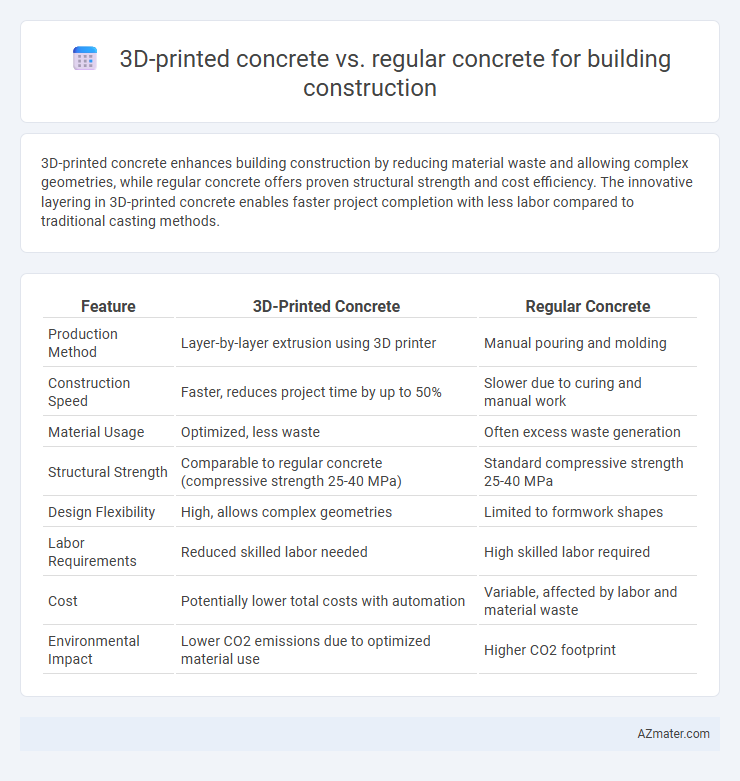3D-printed concrete enhances building construction by reducing material waste and allowing complex geometries, while regular concrete offers proven structural strength and cost efficiency. The innovative layering in 3D-printed concrete enables faster project completion with less labor compared to traditional casting methods.
Table of Comparison
| Feature | 3D-Printed Concrete | Regular Concrete |
|---|---|---|
| Production Method | Layer-by-layer extrusion using 3D printer | Manual pouring and molding |
| Construction Speed | Faster, reduces project time by up to 50% | Slower due to curing and manual work |
| Material Usage | Optimized, less waste | Often excess waste generation |
| Structural Strength | Comparable to regular concrete (compressive strength 25-40 MPa) | Standard compressive strength 25-40 MPa |
| Design Flexibility | High, allows complex geometries | Limited to formwork shapes |
| Labor Requirements | Reduced skilled labor needed | High skilled labor required |
| Cost | Potentially lower total costs with automation | Variable, affected by labor and material waste |
| Environmental Impact | Lower CO2 emissions due to optimized material use | Higher CO2 footprint |
Introduction to 3D-Printed Concrete and Traditional Concrete
3D-printed concrete utilizes additive manufacturing technology to layer concrete material precisely, enabling complex architectural designs and reducing material waste compared to traditional concrete methods. Traditional concrete relies on casting and formwork, which often involves extensive labor, longer construction times, and increased material consumption. The adoption of 3D-printed concrete in building construction enhances efficiency, customization, and sustainability while maintaining the structural integrity characteristic of regular concrete.
Material Composition and Technology Differences
3D-printed concrete utilizes a specially formulated mix containing additives like accelerators, fibers, and fine aggregates to ensure optimal flowability and rapid setting, contrasting with regular concrete's traditional blend of cement, coarse aggregates, sand, and water designed for manual pouring and curing. The advanced extrusion technology in 3D printing layers concrete precisely, enabling complex geometries and reducing material waste, whereas conventional concrete relies on formwork and molds, limiting design flexibility and increasing labor. Integration of digital modeling and automated deposition in 3D-printed concrete enhances structural efficiency and customization, distinguishing it from the standard batch mixing and casting processes of regular concrete.
Construction Speed and Efficiency Comparison
3D-printed concrete significantly reduces construction time by automating the layering process, enabling structures to be built up to 50-70% faster than traditional methods. This technology minimizes labor costs and material waste through precise deposition, enhancing overall efficiency and sustainability in building projects. Traditional concrete relies heavily on skilled labor and formwork setup, which prolongs project timelines and increases the potential for human error.
Structural Strength and Durability
3D-printed concrete offers enhanced structural strength due to its layer-by-layer construction, allowing for optimized reinforcement placement and reduced material waste compared to regular concrete. The controlled curing process in 3D printing results in uniform density and fewer micro-cracks, significantly improving durability against environmental stressors. While traditional concrete relies on formwork that can introduce inconsistencies, 3D-printed concrete provides precise geometries and superior bonding between layers, leading to longer-lasting structural integrity.
Design Flexibility and Architectural Possibilities
3D-printed concrete offers unprecedented design flexibility by allowing intricate shapes and complex geometries that are difficult or impossible to achieve with regular concrete. This technology enables architects to optimize structural forms, reduce material waste, and customize building components with greater precision. In contrast, regular concrete relies on conventional formwork, limiting architectural possibilities and often increasing time and labor costs for unique designs.
Cost Analysis: 3D Printing vs. Traditional Methods
3D-printed concrete significantly reduces labor costs by automating the layering process, cutting labor expenses by up to 50% compared to traditional methods, where skilled workers are essential for formwork and pouring. Material savings of approximately 30% are achieved through precise deposition, minimizing waste common in regular concrete construction that often involves excess concrete and formwork material. While initial investment in 3D printing equipment may be high, the overall project cost decreases by 20-40% due to shorter construction timelines and reduced need for scaffolding and molds.
Sustainability and Environmental Impact
3D-printed concrete significantly reduces material waste and lowers carbon emissions compared to regular concrete by using precise additive manufacturing techniques that minimize excess usage. This technology often incorporates recycled materials and requires less energy for curing, contributing to a smaller environmental footprint in building construction. Additionally, 3D-printed concrete enables faster construction times, reducing onsite pollution and resource consumption associated with traditional methods.
Labor Requirements and Skill Sets
3D-printed concrete significantly reduces labor requirements by automating the layering process, minimizing the need for large construction crews typically required for regular concrete work. The skill set for 3D-printed concrete construction shifts towards specialized knowledge in digital design, robotic operation, and material science, contrasting with the traditional manual craftsmanship and formwork expertise needed for conventional concrete projects. This evolution in labor and skill demands leads to faster project timelines and potentially lower labor costs while emphasizing technical proficiency in construction technology.
Quality Control and Safety Considerations
3D-printed concrete offers enhanced precision in layer deposition, reducing human error and improving consistency in material properties compared to regular concrete, which relies heavily on manual mixing and pouring techniques. Quality control in 3D-printed concrete incorporates real-time monitoring through sensors, enabling early detection of defects or irregularities, whereas traditional concrete quality testing occurs post-application through sampling and lab analysis. Safety considerations for 3D-printed concrete include ensuring structural integrity through advanced design algorithms and material formulations, while regular concrete demands rigorous curing processes and formwork stability to prevent structural failures.
Future Trends in Concrete Construction Technologies
3D-printed concrete offers significant advancements over regular concrete by enabling faster construction times, reduced labor costs, and complex architectural designs through automated layering techniques. Emerging trends in concrete construction technologies emphasize sustainability with eco-friendly mix designs and the integration of smart sensors to monitor structural health in real-time. Future developments are expected to combine additive manufacturing with AI-driven optimization to enhance material efficiency and durability in large-scale building projects.

Infographic: 3D-printed concrete vs Regular concrete for Building construction
 azmater.com
azmater.com